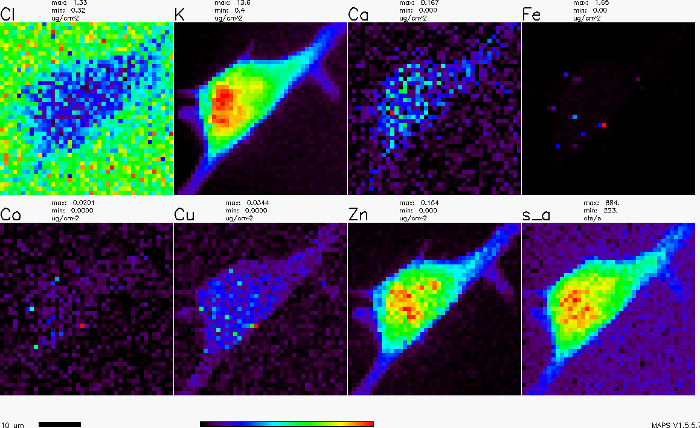Röntgen-Fluoreszenz (XRF)
Überblick
Quelle: Labor von Dr. Lydia Finney — Argonne National Laboratory
Röntgen-Fluoreszenz ist eine induzierte, emittierte Strahlung, die verwendet werden kann, um spektroskopische Informationen zu generieren. Röntgen-Fluoreszenz-Mikroskopie ist eine zerstörungsfreie bildgebendes Verfahren, das die induzierte Fluoreszenzemission von Metallen zu identifizieren und quantifizieren, deren räumliche Verteilung verwendet.
Verfahren
1. Vorbereitung der Silizium-Nitrid Windows
- Umgekehrte Pinzette ein Fenster (Siliziumnitrid, die Windows erschüttern werden herunterfallen) abholen.
- Legen Sie Fenster auf einen Objektträger, flachen Seite nach oben.
- Halten Sie kleine Stücke Klebeband an den Seiten des Fensters zu, und verwenden Sie diese, um die Fenster am unteren Rand der Kulturschale zu halten.
- Sterilisieren Sie die Fenster in Kultur Gerichte mit UV-Bestrahlung. Kann dies mit der Auto-Crosslink-Einstellung auf
Ergebnisse
Die Röntgen-Fluoreszenz-Karte von eine adhärente Zellen ist in Abbildung 1dargestellt. Jedes Panel zeigt die Verteilung eines bestimmten Elements (z. B. Kupfer, Eisen, Zink usw.) über die Zelle. Das Gremium beschriftet "S_a" zeigt die Absorption von Röntgenstrahlen.

Abbildung 1: Röntgen-Fluoreszenz-Karte von eine adhärente Zellen.<...
Anwendung und Zusammenfassung
Röntgen-Fluoreszenz-Bildgebung kann ein nützliches Instrument in vielen Bereichen einschließlich der Geowissenschaften, Kriminaltechnik, Materialwissenschaften, Biologie und auch im Studium unseres kulturellen Erbes. In der Materialwissenschaft kann es helfen, Fehler in Chips und Katalysatoren, die mit Metallen zu finden. In Kulturerbe arbeiten hat es um giftige Metalle in den Haaren der berühmten Toten (z. B. Beethoven) zu identifizieren und zur Identifizierung der Quelle von Lacken verwendet in der Kunst eingesetzt...
Tags
pringen zu...
Videos aus dieser Sammlung:

Now Playing
Röntgen-Fluoreszenz (XRF)
Analytical Chemistry
25.8K Ansichten

Probenvorbereitung für die analytische Charakterisierung
Analytical Chemistry
85.1K Ansichten

Interne Standards
Analytical Chemistry
205.2K Ansichten

Standard-Additionsverfahren
Analytical Chemistry
320.5K Ansichten

Kalibrierkurven
Analytical Chemistry
798.2K Ansichten

UV/Vis-Spektroskopie
Analytical Chemistry
624.7K Ansichten

Raman-Spektroskopie für die chemische Analyse
Analytical Chemistry
51.4K Ansichten

Gaschromatographie (GC) mit Flammen-Ionisations-Detektion
Analytical Chemistry
282.7K Ansichten

Hochleistungs-Flüssigkeitschromatographie (HPLC)
Analytical Chemistry
385.5K Ansichten

Ionenaustausch-Chromatographie
Analytical Chemistry
264.8K Ansichten

Kapillarelektrophorese (CE)
Analytical Chemistry
94.2K Ansichten

Einführung in die Massenspektrometrie
Analytical Chemistry
112.6K Ansichten

Rasterelektronenmikroskopie (SEM)
Analytical Chemistry
87.3K Ansichten

Elektrochemische Messungen von Trägerkatalysatoren mit einem Potentiostat / Galvanostat
Analytical Chemistry
51.7K Ansichten

Zyklische Voltammetrie (CV)
Analytical Chemistry
125.7K Ansichten
Copyright © 2025 MyJoVE Corporation. Alle Rechte vorbehalten